NGC Ancients: Sea Creatures on Greek Coins
Posted on 7/11/2017
Finely engraved images of animals and mythic creatures are commonplace on ancient Greek coins. The spectrum is incredible, ranging from imaginary creatures to the kinds of animals the ancients encountered in everyday life.
Among the most frequently shown are aquatic creatures. This is hardly surprising as seas and rivers were vital to the Greeks, who depended upon them for food, trade and travel.
 |
|
| A silver litra from Syracuse. | |
 |
|
| A copper Onkia from Syracuse. | |
There is no better place to start a visual survey than at Syracuse, one of the great maritime cities of the Greek world. Above are two coins that show an octopus. The first is a silver litra likely struck in the 460s B.C.; the second is a copper coin struck a little more than a century later, and in a distinctly different style.
In both cases, one can appreciate how the artists were careful to present the octopus with accuracy.
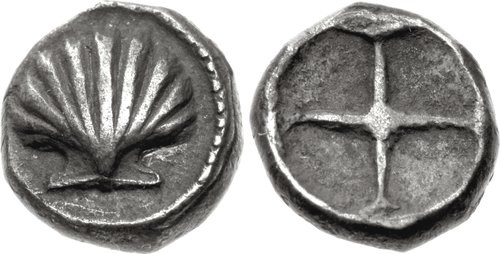 |
|
| A litra from Taras. | |
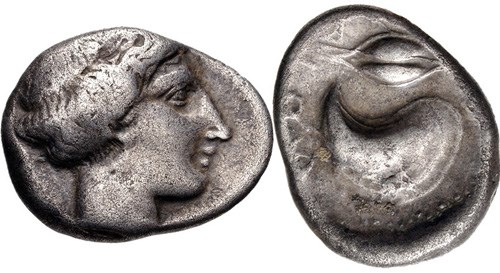 |
|
| A didrachm from Cumae. | |
Also common in the sea and in rivers were shell creatures that the Greeks harvested for food and for commercial use. Shown above are two types of shells as portrayed on silver coins from Southern Italy. First is a cockle shell on a litra of Taras struck in the 480s or 470s B.C.; second is a mussel shell (beneath a grain ear) on a didrachm of Cumae from the late 5th or early 4th Centuries B.C.
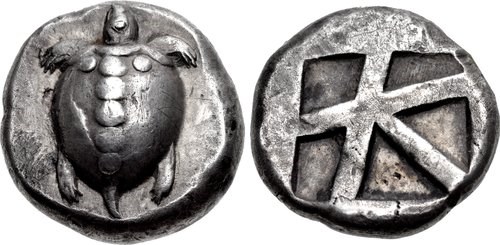 |
|
| A silver stater from Aegina. | |
And now for a completely different kind of shell – one attached to a turtle. The Greek island of Aegina, not far from Athens, struck untold millions of silver staters depicting sea turtles from the mid-6th through the mid-5th Centuries B.C. The example shown above is especially well detailed.
The tuna fish (‘tunny fish’) was an important resource for the ancient Greeks, especially those along the waterway that linked the Aegean Sea and the Black Sea. The most powerful city in that region, Cyzicus, routinely portrayed the tunny fish on its coinage.
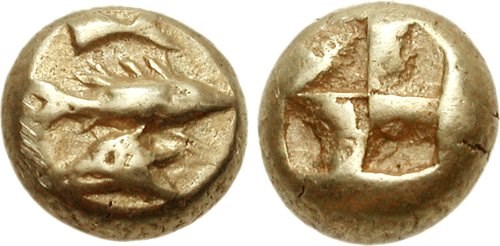 |
|
| A twelfth-stater from Cyzicus. | |
Shown above is a twelfth-stater issued at Cyzicus between c.600 to 550 B.C. It is made of electrum, an alloy of gold and silver, and offers a most inventive design showing a full tunny fish beneath a tunny tail and a tunny head.
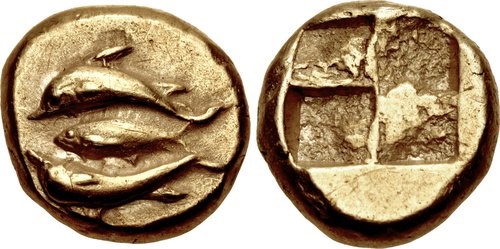 |
|
| A sixth-stater from Cyzicus. | |
A tunny also appears on the Cyzicus electrum sixth-stater (‘hecte’) shown above. It was struck sometime between about 550 and 450 B.C. and shows two dolphins surrounding a tunny fish.
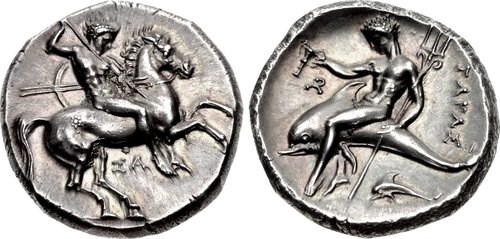 |
|
| A didrachm from Taras. | |
Dolphins are perhaps the most frequently depicted sea animal on Greek coins. Shown here are three examples in silver. First is a didrachm of Taras from the late 4th Century B.C. which portrays a young man riding a dolphin – an endearing scene that relates to the foundation mythology of the city.
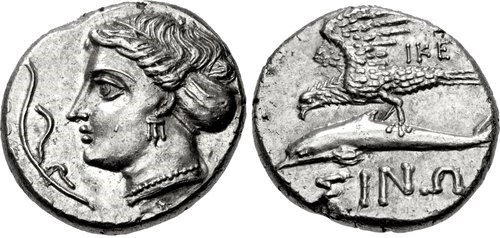 |
|
| A didrachm from Sinope. | |
Second is a drachm of Sinope, a city on the southern coast of the Black Sea. It also was struck in the late 4th Century B.C., and it shows a most intriguing scene of an eagle perched on the back of a dolphin. This image is hard to interpret: is the eagle attacking the dolphin, or are the two animals somehow engaged harmoniously? Unfortunately, the answer is not recorded in the surviving ancient literature.
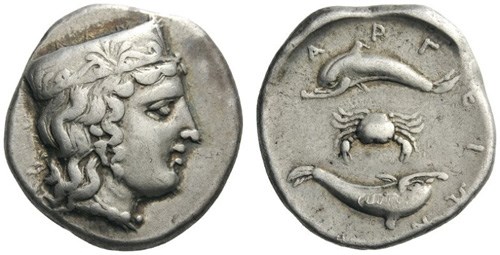 |
|
| A stater from Argos. | |
Next is a stater of the mid-4th Century B.C. from Argos, a city of the Greek Peloponnesus. On its reverse is a beautiful composition in which two dolphins encircle a crab.
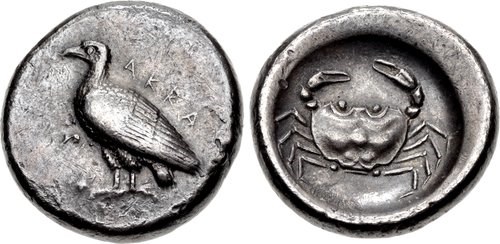 |
|
| A didrachm from Acragas. | |
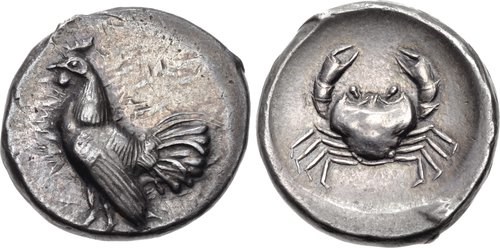 |
|
| A didrachm from Himera. | |
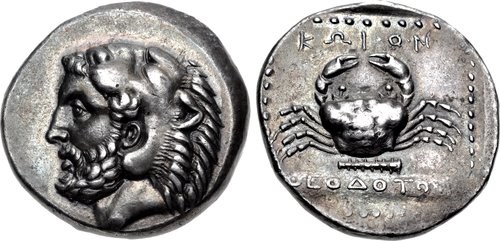 |
|
| A tetradrachm from the island of Cos. | |
Crabs appear on a large number Greek coins, including the three silver coins illustrated above: didrachms of the Sicilian cities of Acragas (late 6th Century B.C.) and Himera (early 5th Century B.C.), and a tetradrachm of the island of Cos (mid-4th Century B.C.).
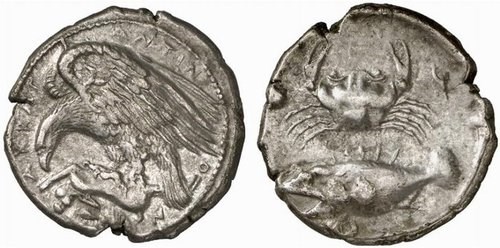 |
|
| A tetradrachm from Acragas. | |
Other coins of Acragas portray crabs along with a variety of other sea creatures. They include the rare silver tetradrachm of the late 5th Century B.C. illustrated above. It shows a large fish – a grouper, and perhaps specifically a mero – beneath a crab, which is flanked by a cockle shell and a sea snail (both of which are hard to see due to an incomplete strike).
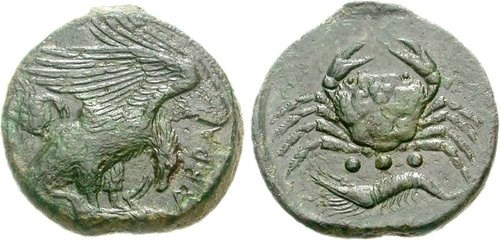 |
|
| A tetras from Acragas. | |
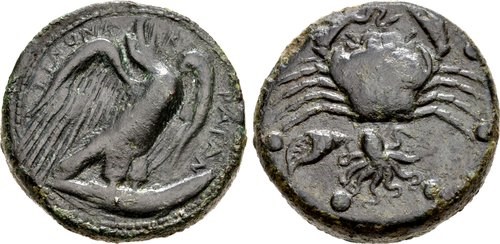 |
|
| A hemilitron from Acragas. | |
We continue at Acragas with the two copper coins shown above, both of the late 5th Century B.C. First is a tetras that shows a crab over an intricately detailed crayfish; next is a hemilitron that shows a conch shell and an octopus beneath a crab that clutches a sea snake.
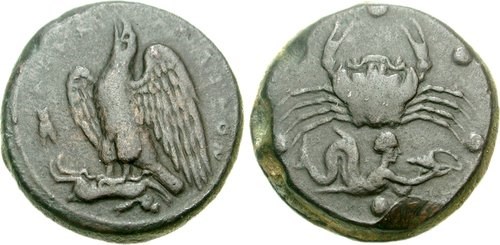 |
|
| A hemilitron from Acragas. | |
A perfect way to end this survey is with some fanciful marine creatures from the realm of mythology. We’ll start with a copper hemilitron of Acragas from the late 5th Century B.C. that is illustrated above. It shows a marine deity – perhaps a Triton – holding aloft a conch shell with which he appears ready to make a thunderous sound.
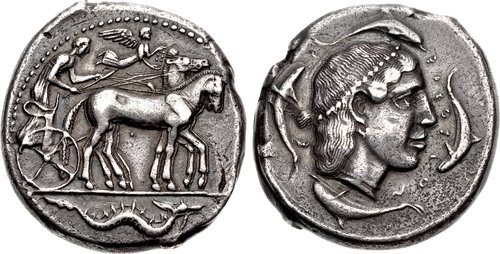 |
|
| A tetradrachm from Syracuse. | |
Next is a silver tetradrachm of Syracuse from the 460s B.C., shown above, which depicts a chariot, beneath which is a serpent-like sea creature called a ketos.
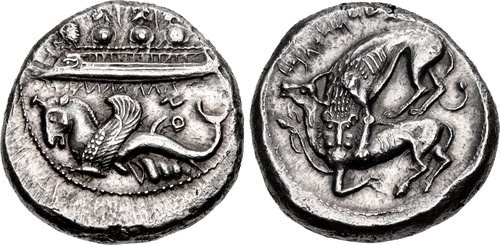 |
|
| A shekel from Byblos. | |
Equally fantastic is the hippocamp beneath a war galley on a silver shekel (above) issued c.400 to 365 B.C. at the Phoenician city of Byblus. A further marine element is the murex shell nestled beneath the hippocamp.
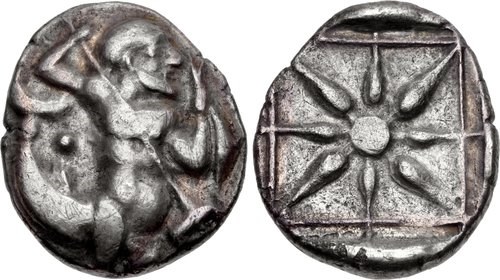 |
|
| A stater from Itanus on the island of Crete. | |
Finally, we can enjoy the silver stater above, which was issued c.380 to 350 B.C. at the city of Itanus on the island of Crete. It features a marvelous marine deity, comprised of a male human torso and a fish tail, which holds a fish and a barbed trident.
Interested in reading more articles on Ancient coins? Click here
Images courtesy of Classical Numismatic Group.
Stay Informed
Want news like this delivered to your inbox once a month? Subscribe to the free NGC eNewsletter today!
Add Coin
Join NGC for free to add coins, track your collection and participate in the NGC Registry. Learn more >
